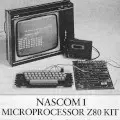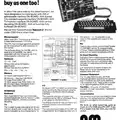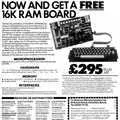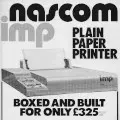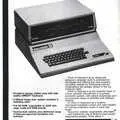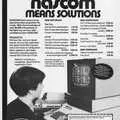
Nascom/Lucas Advert - January 1980
From Personal Computer World
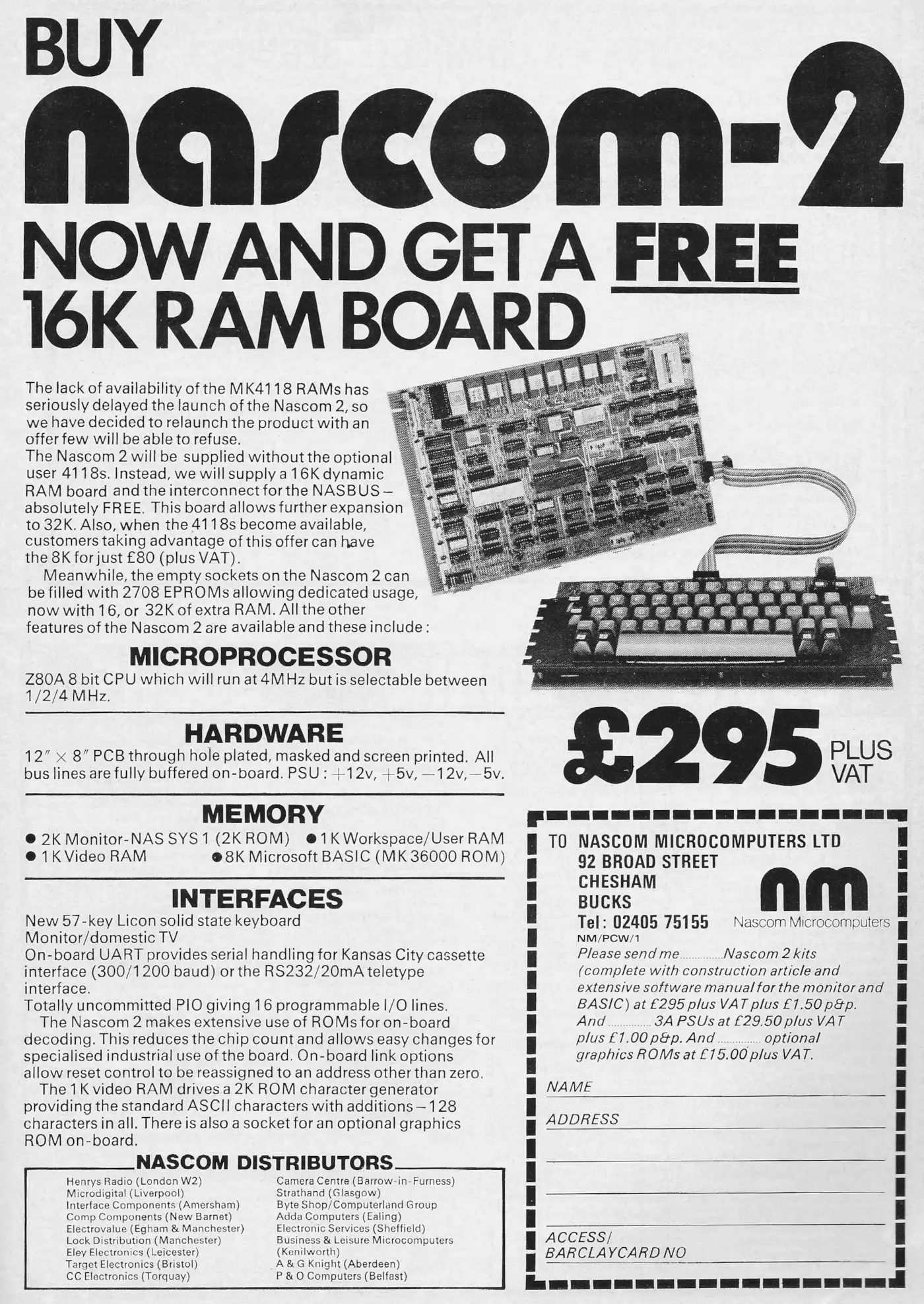
Buy Nascom 2 Now and get a free 16K RAM board
The Nascom 2 was one of a range of kits produced by UK computer manufacturer Nascom, a company founded by John Marshall and Kerr Borland.
The previous model, the Nascom 1, had been designed primarily as a way of getting in to semiconductor component distribution, as this was significantly cheaper than carrying enough stock to satisfy random orders for individual components. Marshall said:
"It was cheaper to design a single-board computer which might sell between 300 and 500 models than to try and market the required components direct".
However, initial orders racked up in the thousands, making the Nascom 1 Britain's top-selling kit in 1979.
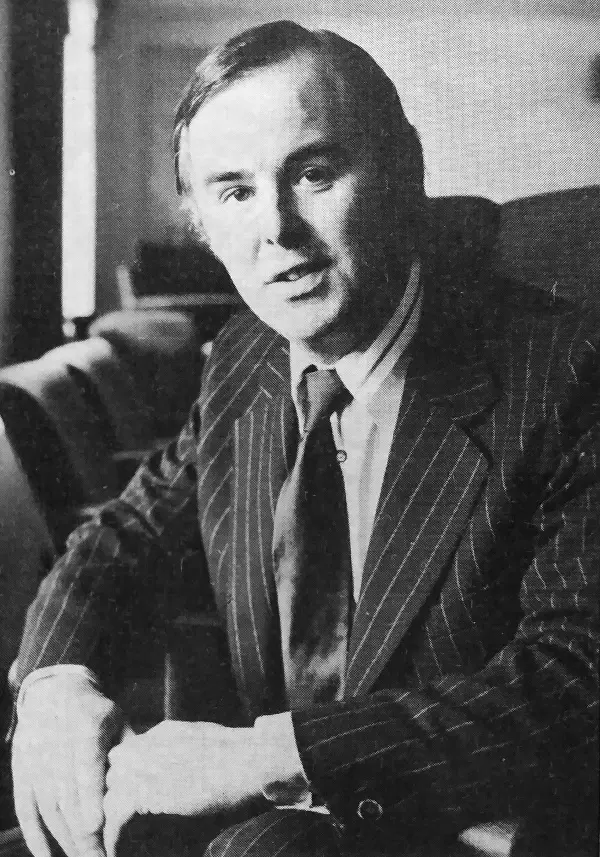
Kerr Borland, © Your Computer February 1982
Following that, Borland worked at calculator company Sumlock, before a stint as UK marketing manager of North American Semiconductor in 1977.
It was whilst here that Borland and Marshall started casting around with the idea of a sub-£200 micro - at the time something that many thought could not be done.
Their idea was eventually taken up by Chris Shelton, later of Shelton Instruments - a company that would later launch early networking system the Sig/Net.
On the first day of the Nascom 1's launch, in January 1978, the company received 300 orders and had soon racked up 7,000 further enquiries.
It was perhaps not surprising as its price - £200 compared to the £600+ of its competitiors - the Commodore PET, TRS-80 and Apple II - together with its advanced features made it highly competitive.
However, its low price also meant tiny profit margins, and increasing competition and R&D costs soon led to cashflow issues[1].
This advert, which featured in the January 1980 issue of Personal Computer World, pulls no punches in blaming a shortage of Mostek's MK4118 static memory chips[2] for the delays in getting the Nascom 2 to market.
The company had been waiting since October 1979 for them to appear, but it eventually had to ship without new chips, with a work-around based on slower dynamic RAM[3].
Using dynamic RAM required additional circuitry as dynamic memory used capacitors to keep the chips "charged" in between read cycles, but this wasn't on the original design so an extra board had to be added.
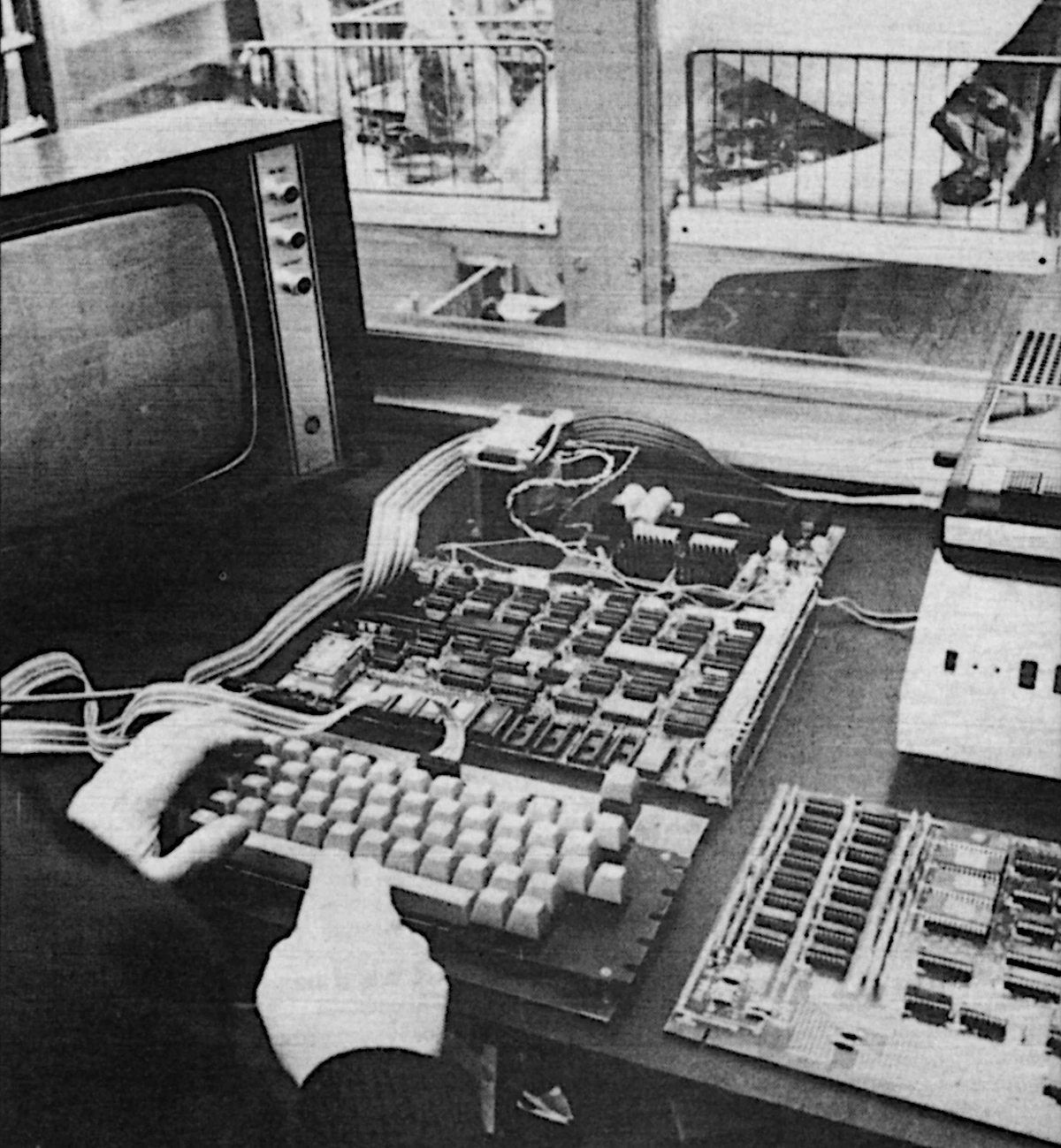
A Nascom board in action, from Practical Computing, October 1981
On the upside, this left eight of the original 10 static memory slots on the motherboard free (Nascom had still managed to source 5,000 of the static chips, of which they needed at least two to run the video display), so Kerr Borland - Nascom's Marketing Manager - decided to offer the ZEAP assembler as an option, which bought the Nascom "up to the level of the AIM-65 from Rockwell"[4].
To sweeten the deal, users would get 16K dynamic RAM and a free interface, but could elect to buy 8K of the faster memory, when it finally became available, for an extra £80 (£570 in 2025, or about £52 million a gigabyte).
The kit, which unsually shipped complete with a fully-functional keyboard and a graphics adapter (something of a rarity at the time for that sort of system) retailed for £295 plus VAT - about £2,440 in 2025 money.
Pre-built versions were on offer from Portable Microsystems, including a briefcase version for £535 (with the Nascom 2 inside) - about £3,840 in 2025.
For an extra £200 (£1,430), you could get an acoustic-coupler modem to go with your "laptop".
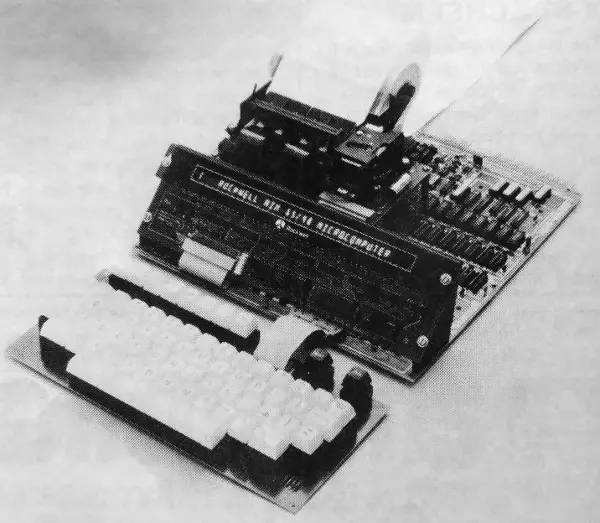
The Rockwell AIM-65, one of Nascom's competitors. © Your Computer March 1982
Nascom seemed to be losing its way around the Spring of 1980, with Personal Computer World commenting on the lack of an obvious update from the Nascom 2 to a newer version 3, in the light of competition from Clive Sinclair's new ZX80.
"Technology has not got stuck since [the release of the Nascom 2] and if Nascom truly wants to sell the way it did in the early days, a £500 system using a CPU that looked reasonable when it was originally announced but won't be available until nearly a year later is not going to steal any thunder from Clive Sinclair".
Although the company had just announced a packaged version of the '2, it was noted that the company seemed more concerned with trying to avoid upstaging its Nascom 1 model, and its attempt to go "up market" was risking the failure that had befallen many companies attempting to leave their core market behind in pursuit of higher profits.
Nascom's MD, John Marshall, had even arranged extra financing from NRDC and Grovewood Securities, the latter having already invested £500,000 in the company the year before[6].
However, he had so far failed to use any of it, with Grovewood saying that he "had until June to make up his mind about whether he wants it"[7], or what.
Nascom was said to have already made plenty of enemies in its early days as poor financing meant that order fulfillment had been patchy.
This was compounded by reduced sales of the Nascom 1 following the announcement of the model 2[8] and the shortage of MK4118 chips - the company had even recruited extra staff to try and sort out its administration issues.
It had spent heavily on development, including £250,000 on the Nascom 2, and it was having to give away free 16K RAM boards to gloss over the chip-shortage problems.
It also had the problem that by the time the Nascom 2 had launched, it was into a market saturated by many other micros available at around the same price.
Although the NAscom 2 was a "technical success", the company was facing more and more cash-flow problems, which came to a head leading it to ask Grovewood Securities to call in the receivers at the end of May 1980[9]. The timing was particularly unfortunate as Nascom had just started making some money again, even though it was still paying its bills in cash on a day-by-day basis.
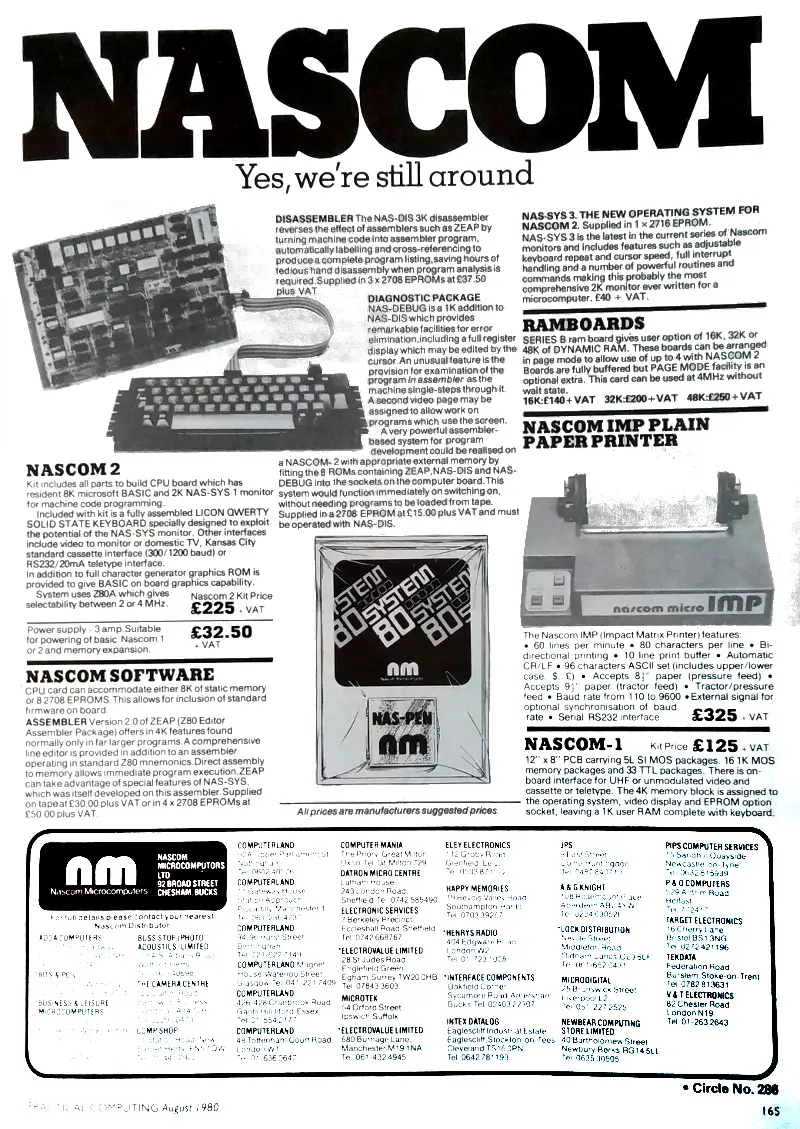
Nascom: we're still around, © Practical Computing August 1980
However it didn't take too long before the first rumour of a rescue appeared.
John Margetts, a member of the Nascom Microcomputer Club, was reported to be considering forming a company which would be funded by other Nascom users and distributors in order to buy out the company from the receiver.
Apparently, the receiver considered that this could be a viable deal, although it was uncertain actually how much money was involved.
It didn't seem like it was actually that much, as Margetts was hoping to raise the money by selling 50p shares in the company in chunks of 20[11].
On the upside, it was being reported that people still seemed to have faith in the Nascom micro and that there would still be a market for it in the near future, as even after the initial collapse of the company, products - such as Winchester Technology's Teletext board - were still being announced[12].
The Margetts rescue attempt didn't come to pass, and it was followed by another attempted buyout by the owner of a Watford-based PCB company, Manas Heghoyan, who was expecting to pay somewhat less than the £500k debts that remained after Grovewood Securities bought the receiver in.
Heghoyan had cut his teeth as a computer designer and had worked on English Electric's System 4 mainframes in 1965, before they were killed off when ICL bought the company and switched to selling the ICT 1900 instead - a computer produced by International Computers and Tabulators, before that company's absorption into ICL. He then built his PCB company the hard way, acting "as architect, builder and financier".
The potential new owner had even recruited the services of one-time software director of Nascom, Tony Rundle, to help steady the ship - probably to the relief of the 19,000 or so existing users of Nascom's systems[13].
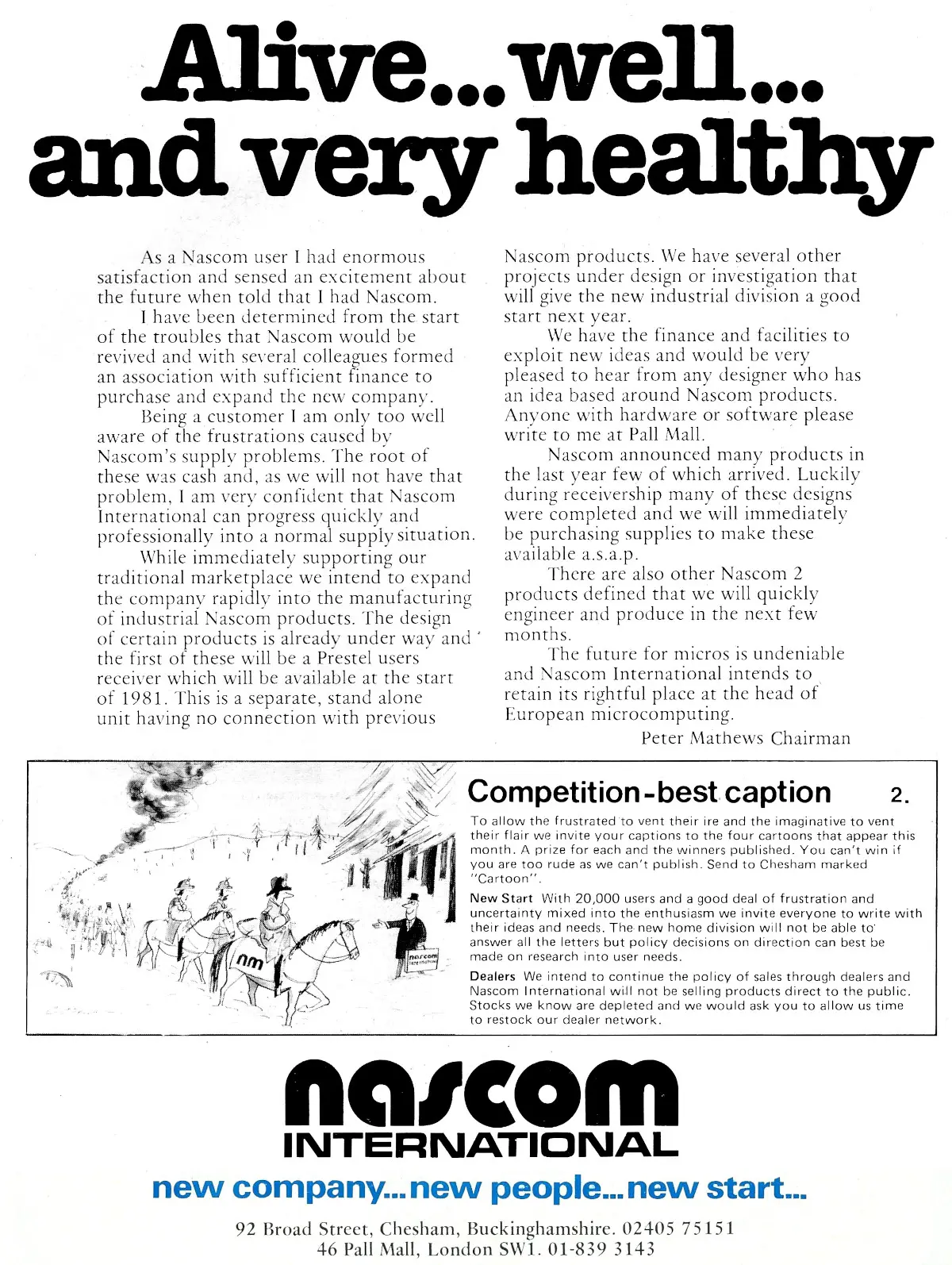
Nascom has a bit of a re-launch towards the end of 1980, with a slight rebrand to Nascom International. From Personal Computer World, December 1980
Meanwhile, the "new" Nascom was quick to take out adverts in the press reassuring existing users and potential customers that things were well. New chairman Peter Matthews wrote:
"Being a customer I am only too well aware of the frustrations caused by Nascom's supply problems. I am very confident that Nascom International can progress quickly and professionally into a normal supply situation. I intend to expand the company rapidly into the manufacturing of industrial products. The design of certain products is already under way and the first of these will be a Prestel receiver which will be available at the start of 1981. We have the finance and facilities to exploit new ideas and would be very pleased to hear from any designer who has an idea based around Nascom products"[14].
The Heghoyan bid, despite being approved by the receivers, failed to reach completion, with Nascom remaining in receivership for the next two years. However its move in to industrial products seemed to help it when it was eventually acquired by Lucas Logic sometime in 1982.
Borland apparently had high regard for Lucas's management team, but wasn't sure that Lucas knew what it had let itself in for, saying:
"I think that Nascom's new management has a great problem. Lucas is a superbly set-up company, but it is used to operating in an entirely different field. I feel that Lucas has found itself in a retail market which it didn't really forsee".
Borland also reflected on his time at Nascom, reckoning that "[trying] to do it all by yourself was really a very risky thing to do in an area where you have multi-billion dollar companies"
After Nascom had been handed over to the receivers, John Marshall set up a new components company called Interface.
By the summer of 1980 he had already secured a PET franchise, was acting as a Sharp agent and was in the process of trying to secure a spot as an Apple dealer[15].
One of the first products that Marshall's new company produced was... a board designed to hold Nascom firmware[16].
This seemed to be fairly short lived, as Marshall also started a new microcomputer company - Gemini - initially in order to build peripherals and plug-in boards to the Nasbus standard. Nascom had shipped some 35,000 units by May of 1980[17], so there was a large potential market.
Marshall had to use his own house as collateral against a bank loan to start the new company up, but somewhat surprisingly managed to get all but one of his previous Nascom suppliers to provide a credit line, despite Nascom's previous spotty history of paying on time, and the losses they had suffered when the receivers were called in.
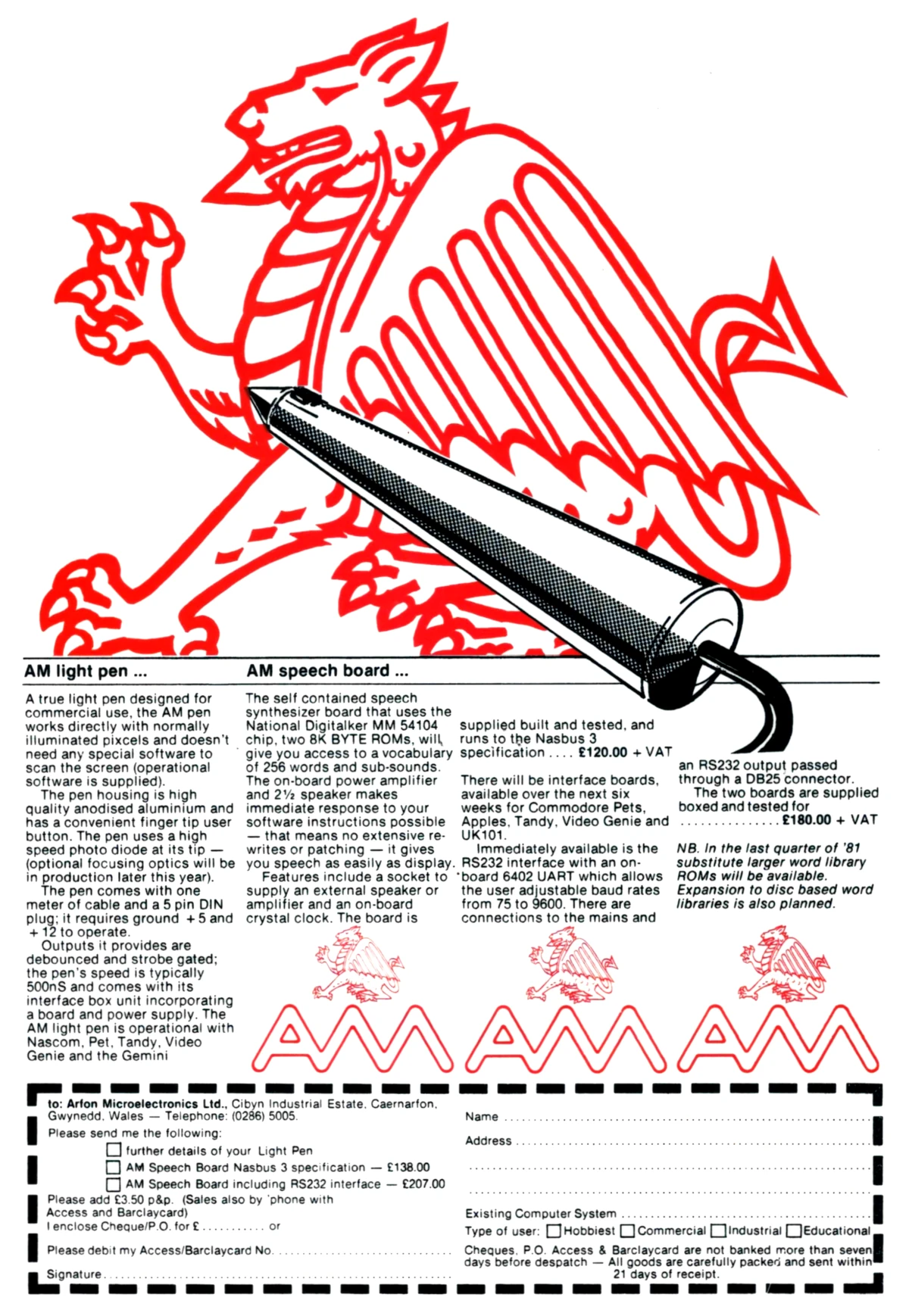
An advert from Kerr Borland's company Arfon Microelectronics pre-announcing its AM Light Pen, which would work with Nascom, PET, Video Genie, Tandy and Gemini micros, along with the AM Speech Board with a NasBus 3 interface, and a pricy-sounding RS232 (serial) interface, for £180 + VAT, or around £1,070 in 2025.
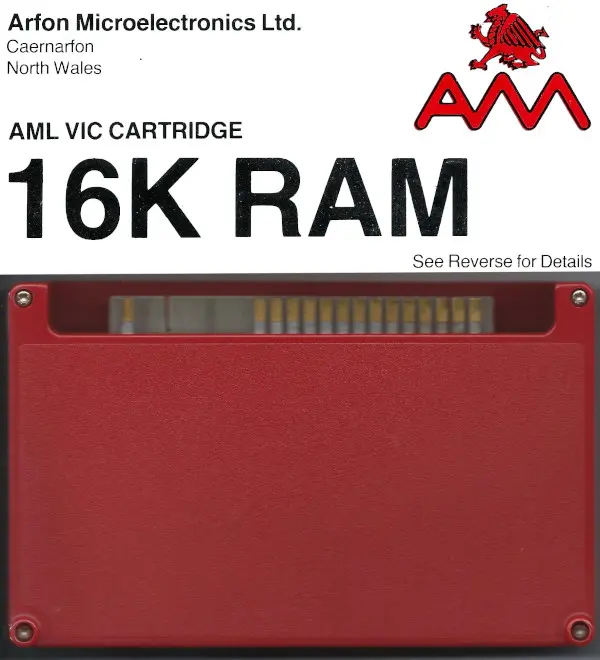
An Arfon Microelectronics 16K static ram cartridge for a VIC-20
The attractions of the computer industry seemed to prove too strong as by 1980 Borland had set up Specialist Micro Designs, which he even managed to attract a couple of Nascom's former engineers to join.
By the end of 1980, Borland had formed Arfon Microcomputers Ltd, based in Caernarfon in North Wales, to produce peripherals for computers like the PET, Tandy, Apple and his old micro the Nascom.
By early 1982, Arfon added Commodore's VIC-20 to its roster and sold 2,000 of its new seven-cartridge expansion units in only four weeks.
Borland also seemed to be a fan of Commodore's Kit Spencer, whom he credited with being "the most dominant man in Europe" - presumably solely in a computer context - for his one-time winning of 70% market share for the PET[19].
Date created: 28 July 2013
Last updated: 06 August 2025
Hint: use left and right cursor keys to navigate between adverts.
Sources
Text and otherwise-uncredited photos © nosher.net 2025. Dollar/GBP conversions, where used, assume $1.50 to £1. "Now" prices are calculated dynamically using average RPI per year.
